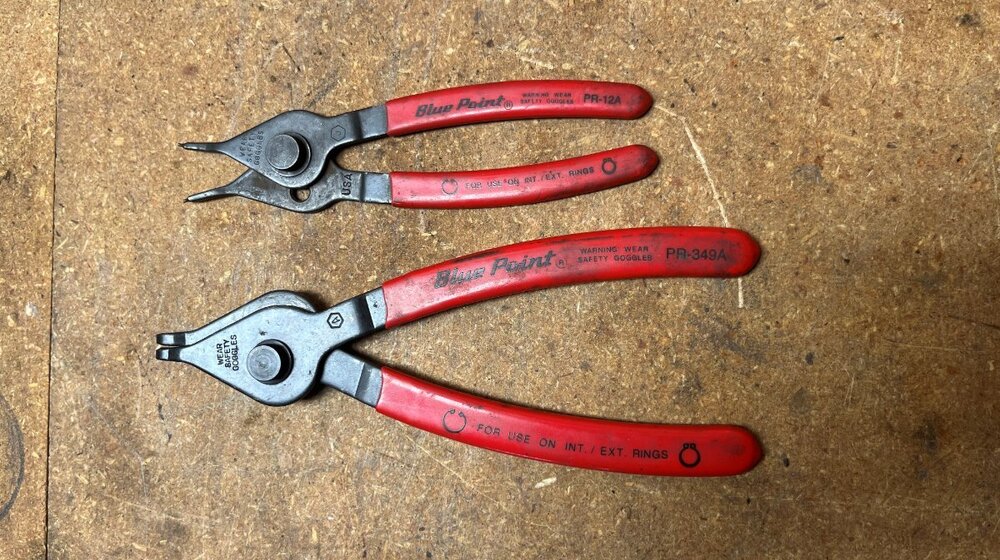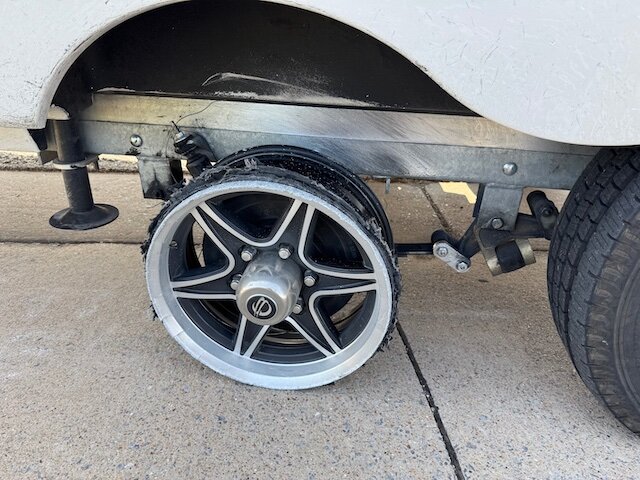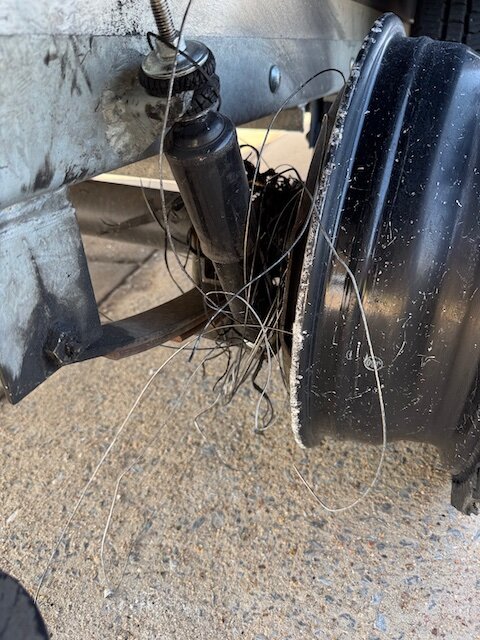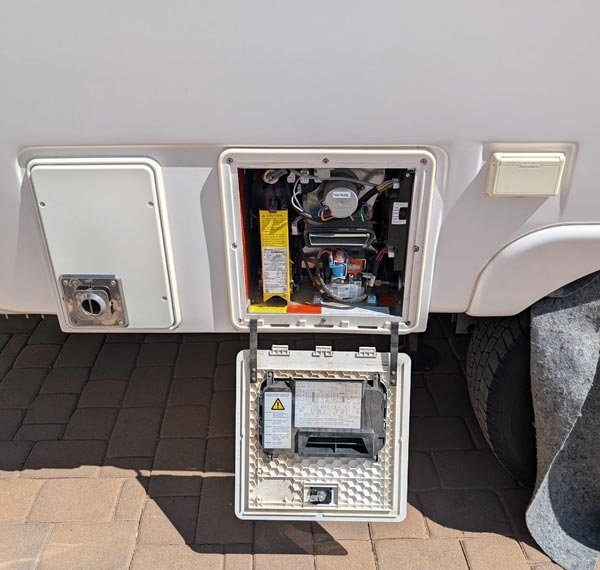Leaderboard
Popular Content
Showing content with the highest reputation on 09/26/2025 in all areas
-
3 points
-
Sorry for not posting this sooner. An Oliver friend was at Harbor Freight today asking me the same question, so I went out to my garage and measured. The large snap ring has holes 0.11" ID and they are 1 1/4" apart. The snap-ring pliers I used for this has pins 0.07" OD and has a reach of about 1 1/2". The very small snap ring has holes about 0.05" and are only 1/4" apart. The snap-ring pliers I used for this has pins 0.04" OD. These are the tools I used. Zoom in to see tool part numbers.3 points
-
3 points
-
Glad you guys are OK and that there wasn't any more damage than you had. I believe that your experience was ( as you mention) partially your "fault" due to not turning on your TPMS. However, the extent of your tire issues is very extraordinary. I don't think that you can prepare for every possible situation while on the road - unless, perhaps, you are ScubaRx 😇. Yes, checking your spare tire air pressure should be done more often OR simply get yourself another TPMS sensor for that spare and remember to turn that TPMS monitor on. I also agree with the advice concerning the use of the onboard "leveling" jacks. Your experience is yet another reason why we bought an Oliver and believe that everyone should consider before purchasing virtually any other brand. Bill3 points
-
Saw an Ollie roll past on 191 in Wyoming heading south near Bondurant at 9:45 this am- kind of exciting! Beautiful day for travel!2 points
-
Tony, I and others on here have been running the 507 TST TPMS. I can’t speak for others, but our system has served us really well for the last 5.5 yrs in. TST I think is based out of Georgia and their customer service is nothing short of stellar. As @Mike and Carol mentioned it measures pressure and tire temp as well. I run the Discount tire rubber stems and have been happy very with this set up. Not to go down the rabbit hole on tire stems, but….metal stems can bend and leak on impact from road debris especially if off pavement. My guys at DCT did NOT recommend metal stems. It’s a personal choice. Go with what your happy with and works. As @topgun2 suggests get the 6 pack of stem cap monitors so you have a sensor for your spare and have an extra. The rubber mount that the TST dash monitor is cradled in works nice and keeps it from moving around on the dash. I use it all the time. For warranty reasons, TST requires you run the repeater which is an easy 12v hook up. I attached mine to the interior of the battery box with velcro. If you decide on this TPMS hit me up with a PM if you have any install questions. It’s pretty straight forward. Once you have your tire caps on and “synch up” with your charged up dash monitor, you are good to go. I think the battery is a 2032 which is installed in each tire sensor. I change these out once per year. This is amazon’s price, shop around you may find it cheaper. https://www.amazon.com/dp/B07FKTH136?tag=track-ect5-usa-1802408-20&linkCode=osi&th=1&psc=1 Safe Travels!2 points
-
Don't forget to get two "extra" sensors - one for the Ollie spare tire and on for you tow vehicles spare tire (all the TPMS systems that I know of that are included on vehicles do not monitor the spare tire on the tow vehicle). Bill2 points
-
@Michael A Are you original owners? The cigarette lighter plug and 110V adapter in your picture look like aftermarket cables somebody just put there, not something OTT installed. You certainly want to take the advice from Mossey. Both adapters pictured are disconnected, but what is at the other end of the cables? What is disconnected? My guess is nothing and you could toss these out! The panel comes out simply held by two bolts along the bottom (3/8" or maybe 10mm). We had some items like this in our attic when we purchased used. I removed everything from prior owners, wiring not OEM. I also refuse to power anything with a cigarette lighter connection when they can be reliably hardwired behind the "wall panel" (attic left cover plate).2 points
-
In the last 6 months we have shown our Oliver twice to prospective buyers. These showings were scheduled with us and the prospective buyers by Oliver Sales. After the showing a few weeks later we received a checks for $50 for each showing. If the prospects end up purchasing a new Oliver (completed signed contract) we will receive an additional $200 for each showing.2 points
-
On our last trip, we had significant tire issues (we replaced two tires, one valve stem, and one wheel), so I wanted to share a little of what we experienced and hope to hear from others on ways to make the next time easier. What happened: Entering Wichita Falls, TX on US-281 from the south driving around 60-70 mph, we heard an unfamiliar noise that we couldn't place or locate. The noise would come and go. Five miles later we exited the freeway onto the frontage road, stopped on the shoulder, and hopped out to make sure everything was alright. It wasn't. The right (curbside) rear (RR) tire was gone. Its wheel was an aluminum nub. Some thoughts: Our LE2 handled fine. I think the weight distribution hitch/anti-sway really helped. The noise coming and going was due to us driving near concrete barriers on the side of the road that reflected the noise back to us, such as on a bridge. When we were on straight road, we couldn't hear or feel anything. We were lucky. No damage other than scratched gel coat. There was a considerable amount of steel cable wrapped around the axle and brake area. Taking the tire off: The first task was to get the trailer "jacked up". We pulled forward onto our Andersen Rapid Jack to elevate the right, front (RF) tire. This worked well until the RF tire went flat also. In addition, taking the weight of the trailer off the RR wheel made it more difficult to remove the lug nuts. Fortunately, a passerby stopped to help us and had a powerful impact wrench and an extender since the lug nuts are recessed quite a bit and the center dome got in the way of the wrench. Also, my personal wire cutters were no match for the steel cables. We needed heavy-duty snips to remove all the cables. It was apparent that we were not fully prepared for this situation, so we called a mobile RV repair person. He ended up using a low-profile hydraulic jack to hold up the trailer. Some thoughts: If we had simply run over a nail, we would have been fine. The Rapid Jack would have been all we needed. I have to upgrade my wire snips and am struggling with choosing a hydraulic jack. A low-profile jack is bulky and heavy, can get into places with low clearance/uneven terrain, and has extended lift range. Bottle jacks are smaller and lighter, but have more limited lift range. Any thoughts on what you use? Where to place the jack? The trailer has a jack point for the frame, but, rightly or wrongly, the repair guy put his jack behind the wheel near where the bolts are in the photo below. Getting to our spare: This wasn't a big deal. We do have the rear bumper receiver but it slid out easily. I was glad that the spare had good pressure since I hadn't checked it in about a year. Some thoughts: Check your spare. I had even installed a tire valve extension (something like this) to make it easier to check and fill. Put this task on a checklist to do periodically. Putting a good tire on: A full light truck tire is bigger and heavier than a passenger tire. Also, a full tire has a larger radius than a flat tire which means the tire may need more clearance. Changing it on uneven ground introduces clearance issues if the axle is not up high enough. Since we had lost our tire, once we put the new one on, we spun the tire and checked for brake operation. We found a 3 second delay from the pedal push to the application of the brake on the wheel. This caused us some concern at the time, but both our technician and myself confirmed that the delay was due to the truck's brake controller. It's probably obvious, but put the wheel on and hand-tighten the lug nuts with the wheel off the ground and then tighten the lug nuts to the proper torque (we did have a torsion bar) when the wheel is on the ground and won't spin freely. Some thoughts: If you are going to check your trailer brake while the wheel is jacked up, use the manual control on your brake controller, not the floor brake pedal. A second tire went flat: Our hearts sank as we watched the RF tire lose pressure as the RR tire was replaced. We only had one spare. The technician's fix was to pull out a can of fix-a-flat and refill the tire with air. It was enough. Again, we were fortunate to have pulled off the road 2 miles from a great RV park, so we headed over with the technician following us to ensure we arrived safely. Some thoughts: Carry a can of fix-a-flat. Purchasing tires on a trip: The next morning the tire "repaired" with the fix-a flat was flat again. This time we refilled the tire ourselves and drove the trailer to a Discount Tire for a replacement. This store had a limited selection so we only replaced the one bad tire and risked driving to our destination one hour away with no spare. Before leaving, the store manager offered to "top off" all our tires. In the process of putting in air on the left (street) side tires, the TPMS sensors were very difficult to remove. To make a long story short, they were finally removed, the tires topped off, and we were off to our destination (Lawton, OK). Upon arriving in our campsite, a camper remarked that one of our left tires was low. It was flat. We don't know for how much of our hour-long drive it was flat. The next day I brought that tire into a Lawton Discount Tire where they replaced the damaged valve stem and I bought the only compatible wheel they had and a spare tire. Some thoughts: Fix-a-flat works for emergencies, but only to the nearest tire shop. Although limited by the store's available tire selection, it will be a cold day in hell before I ever drive the trailer again without a spare tire available. Lessons Learned: As we pulled away from home, all four of our trailers' tires had TPMS sensors on them. I never pulled out and turned on the monitor. It might not have prevented the blowout (or whatever it was that happened), but the alarm would have told us that there was a problem and we would have pulled over much earlier, reducing risk to ourselves and damage to the trailer. I thought I was prepared for tire issues. In fact, I was only prepared for the simplest, most basic scenario. The next time we go out, we'll have a few more tools. I'm interested to hear from you what's in your tire changing tool kit. Open issues: Still trying to figure out which type of hydraulic jack to bring with us. I'd appreciate your thoughts. Still trying to figure out the correct jack point. I'd appreciate your thoughts on this as well. We hope this has been helpful to some and interesting to others. Let us know your thoughts.1 point
-
Excellent idea Tom! Great install location and repeater location for a good signal when towing. 😎1 point
-
Yes, mine did. It worked pretty well (without the repeater) but there were times when I would loose contact with one tire sensor for a period of time. Once I installed the repeater I’ve had no sensor drop-outs.1 point
-
2 years ago today...TST with 6 sensors and color monitor did indeed come with a repeater...from Amazon :) Has been working great for me. John1 point
-
From the views of it on Amazon it appears that a repeater is included. My EZE tire has now worked without any problems or a repeater for 9 years. Bill1 point
-
Mine came with one, but only purchased it a couple of years ago, so apparently the more recent editions have changed with what is included.1 point
-
We also run the TST and have been very happy with it. It occasionally alarms with the sensor saying one of the tires is at over 200F. A Quick Look in the side view mirrors confirms this is not correct. I think this occurs because of interference from our cell phones, chargers or other electronics in the cab. We plug our repeater into the 12 cigarette style outlet about the cooktop.1 point
-
If you have rubber, make sure to install high-quality STEEL valve stems first. Buy from Summit or local auto parts store, NOT Amazon China-made. Tire companies do not carry them. https://www.summitracing.com/search?SortBy=BestKeywordMatch&SortOrder=Ascending&keyword=steel valve stems There are also TPMS sensors that can be installed inside of the wheel integral to the stem. More expensive and work required in removing the tires/rebalancing but it is the way the industry is going now that all modern vehicles have TPMS built-in. https://www.discounttire.com/accessories/tpms-catalog Best to have wheels balanced after TPMS sensors are installed.1 point
-
Thank you very much, Chris & Stacie! You sold me without trying! 🤣 You linked the silver model and yesterday I purchased the black model Amazon used "Like New" model at a very good price. https://www.amazon.com/dp/B07KSNTSVR/?th=1 Most of us have LP grills too but the induction hotplate has a different purpose (e.g. boil water quickly). When you have 600 Ah you need to use it! We traveled with the Weber Q for 8 years, shown by @Patriot and @Mike and Carol above. The Q is a nice small grill but a single burner design does not allow for indirect cooking (can kill a baked potato quickly)! if you cook smaller, meals for two, the Weber Q is the way to go. The Napoleon is about 5 inches longer and 7 pounds heavier. Our old Weber Q1200 is cleaned up and I gave it our son for his camping trips. https://www.amazon.com/Weber-51190001-Liquid-Propane-Orange/dp/B00RFXRZ9Y/?th=1 For $50 more, we strongly recommend the Napoleon! We use these items and vouch for them: https://www.amazon.com/Napoleon-PRO285-BK-Portable-Propane-Grill/dp/B00J4576FE/?th=1 https://www.amazon.com/Reversible-PRO285X-BK-PRO285-BK-TQ285X-BL-Accessories/dp/B0BJDM93QD/?th=1 https://www.amazon.com/Napoleon-Grills-61286-Premium-Grill/dp/B077SLW6L4/1 point
-
@Townesw I just purchased a new roll of butyl, even though I have some left in an older roll. It's hard to keep butyl, glues and tapes fresh in our very dry Arizona climate. I'm rebuilding the rear stabilizer jacks on our hull which includes removal of the jack post assemblies. They were caulked at both interior and exterior hulls. I'm thinking butyl wrapped in a circle will be easier and cleaner to apply than caulk from a tube. I just received this product today. it looks fresh, of good quality and the roll is huge! This might be worth your consideration and for others reading. https://www.amazon.com/dp/B001FCB4JS/?th=11 point
-
Yes - thanks for sharing your story - even the parts that were not so easy to share. This kind of situation helps us all as both a reminder and (perhaps) as a source of other things that we might consider doing (or not doing as the case may be). Bill1 point
-
Thanks for sharing your story. I think you are correct in that we think we're prepared but in reality, we're prepared for the most basic incident. I think a contributing factor was the Oliver tows so well, you were unaware of the disintegrating tire behind you. In the past, I've relied on the Oliver's jacks to raise the tire high enough for removal and replacement. My thought is to use the scissor jack, that came with the truck, as a back-up jack. I've never had much luck with Fix-a-flat. Instead I carry a tire plug kit and compressor (12v or 120v if you have an inverter). Tire plugs can be controversial. Some feel once you plug a tire, you should replace it as soon as possible. Most tire stores refuse to repair a previously plugged tire. Others plug a tire and just run it. The plug kit allows you to deal with as many flats as you have plugs until you get to a position where you can purchase a new quality tire. In addition to learning from your experience, I've made a note to bring along my impact driver. Thanks again for sharing.1 point
-
Wow, glad you were able to resolve with no accident or damage! Thanks for the write up, it’s proof how well the Oliver tows. General thoughts: Use the onboard leveling jacks. We’ve been doing this for years, to include at Discount Tire on a few occasions and at campgrounds to remove wheels. The TST TPMS shows both pressure and temperature of each tire. I keep the monitor on the dash and do a visual check every 15 minutes or so. Whatever TPMS you use, use it and keep a regular watch on tire health. Mike1 point
-
Rob is absolutely correct! Use your onboard Stabilizer Jacks! It's the easiest and safest way to change a tire. Using the labeled "Jack Points" and the trailer weight shifts and then you have other issues. OTT got legal (not engineering) advice on not using the stabilizer jacks. I have posted before what Oliver wrote in the 2017 User Manual, where they detail the tire change procedure using these jacks. I also carry a bottle jack and jack stand, for more major repairs. Hard to imagine any of this on a 3-year-old hull. I expect and have never seen tires self-destruct in less than 7 years, except for China-made ST tires. If you are original owners, I would think about what may have caused or led to these failures (two tires). The steel cable must be the cable from the blown radial tire The shock bushings look awful. Remove one shock to see if it has compression along the full length. My guess is you need 4 new shocks and if I were you, I would be buying four (4) brand new top-of-the-line LT tires, mounted and balanced at a reputable shop. I'd like to ask again re your tire make-model and running tire pressure. Use your TPMS and "see something, hear something, say something!" When you hear any odd noise, get out immediately and inspect all 8 tires, leaf springs, shocks, etc. Look under to see if you're dragging some road debris, then look again. 😎1 point
-
Good grief this is quite a story and horrible experience. Glad you made it through unscathed. May I ask what tires (LT or ST and or brand) you have or had on your Oliver? PSI setting? I can't imagine what would cause so many tire failures in such rapid succession. To answer your questions I suspect you will receive a variety of different answers but I do not carry a jack along and use the built in electric leveling jacks if needed for an emergency. Oliver no longer recommends this but people have been doing it for years. If I were to bring an extra jack it would be a bottle jack stacked on platforms if needed. I have used bottle jacks directly under those plates exactly where the tech used his jack. BTW looking at those rubber grommets on you shocks they seem over tightened and cracking pretty bad. Might want to consider replacing those too. I have an impact wrench which makes for quick work with tire and wheel work but have never carried it along on trips, though I have thought about it for this very reason. Perhaps I should reconsider this. Good luck getting this all figured out.1 point
-
This is correct. If you show your Ollie be sure to let Oliver Sales know so that when the person you showed your trailer to actually pays for their Ollie you will get a "reward" (i.e. cash). Bill1 point
-
I think they've discontinued the rewards program and gone back to the old site visit system. Saw an email about that recently.1 point
-
1 point
-
I’ve decided to try something new for outdoor cooking. We’ve had the single induction hot plate I mentioned in my post above and it works great both for inside or outside cooking. It’s extremely fast to heat up, and even quicker than gas when adjusting temperature in the middle of cooking. Well we’ve also been hauling a 22 inch folding Blackstone grill around with us for the last 18 months and that’s what we’ve been doing about 90% of our cooking on. Because we’re in the habit of carrying so much gear along with us when we travel, there’s really no room for the Blackstone in the back of the truck, and for that reason I’ve been strapping it on the top of our rear cargo box behind the Oliver. Needless to say I’ve never been very comfortable with that arrangement for a number of reasons, mostly the extra weight it adds to the back of the camper, but also at about 90 pounds, it’s quite heavy and awkward to load up onto the box. After seeing the two burner induction stove Oliver is installing in the new campers, I started thinking about the same concept for a portable induction setup. But I also decided a double burner unit would not be as versatile as just adding a second single burner unit. The double burner models all divide the 1800 watt capacity between the two burners, limiting the cooking heat range of each element. By adding a second single burner hot plate, both would be able to run at the full range of heating capacity at the same time. There are several ways to accommodate the electric demand. I usually set up my camp table next to the curb side outlet for using the hot plate. For the second one I can either run a heavy 25ft cord under the trailer to the pedestal directly, or I can set my EcoFlow lithium power pack under the table and plug directly into it with the second one. I actually did a little experiment this evening running both induction plates off the lithium power pack at the same time just to see how well it would perform and was very pleased with the results. Even with both induction plates running on the highest settings simultaneously, the EcoFlow was still over 1600 watts below its maximum output capacity, and it showed that a full charge would last over an hour at that rate. At a more moderate setting for each hot plate it read that it had about three hours of capacity. I continued my experiment by grilling up two steaks for supper on the system and couldn’t be happier with the results. The steaks were cooked to medium and it took less than fifteen minutes. Including this and the other experimenting I did, the power pack was still at 84% soc, enough for several more meals without recharging. This new cooking arrangement only required the addition of one single element hot plate and an induction ready ceramic coated griddle that spans both hot plates, all of which fits easily in the front closet. And now I won’t have to load and haul the heavy Blackstone around with us anymore. Here are some pictures for entertainment purposes.1 point
-
Welcome As 2019 year owners we are willing to help with questions you may have. see our blog about our unit 505 4-ever-hitched.com Craig1 point
-
1 point
-
Some Ollies are wired differently than others, but on mine the bath light switch is on the underside of the overhead cabinet, above the toilet.1 point
-
Recent Achievements































.thumb.jpg.e34bf01ef7f7d5e99ad31856d45afbeb.jpg)